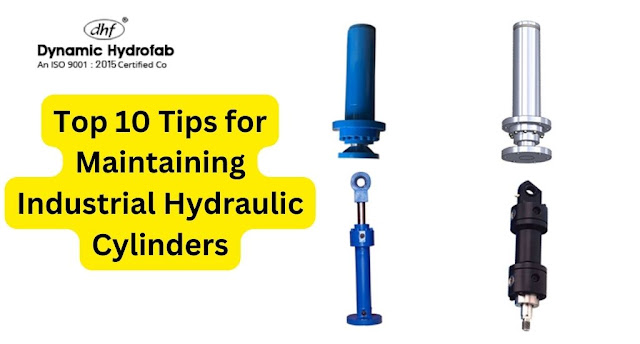Introduction
When it comes to industrial applications, hydraulic cylinders play a crucial role in various processes. These cylinders are responsible for converting hydraulic energy into mechanical force, making them an essential component in industries such as construction, manufacturing, and mining. However, with numerous manufacturers in the market, it can be challenging to identify the top players who provide high-quality hydraulic cylinders for industrial applications. In this article, we will explore the top 5 hydraulic cylinder manufacturers that excel in producing reliable and efficient cylinders to meet industrial demands.
Dynamic Hydrofab
Dynamic Hydrofab is a renowned name in the hydraulic industry and is widely recognized for its exceptional hydraulic cylinder solutions. With a strong emphasis on innovation and reliability, Dynamic Hydrofab has solidified its position as a leading manufacturer in the market. The company offers a wide range of hydraulic cylinders that cater to various industrial applications, ensuring optimal performance and durability. From standard cylinders to custom-made solutions, Dynamic Hydrofab excels in providing high-quality products that meet the specific requirements of industrial clients.
Dynamic Hydrofab is a leading hydraulic cylinder manufacturing company based in Delhi, India. With a strong commitment to excellence, they have established themselves as one of the best manufacturers in the industry. Their state-of-the-art facility, skilled workforce, and advanced technology enable them to produce high-quality hydraulic cylinders that meet the diverse needs of their clients. With a focus on innovation, reliability, and customer satisfaction, Dynamic Hydrofab continues to deliver exceptional products and services to industries across India.
Parker Hannifin Corporation
Parker Hannifin Corporation is another prominent player in the hydraulic cylinder manufacturing industry. With a global presence and a vast array of hydraulic products, Parker Hannifin has earned the trust and satisfaction of its customers. Their hydraulic cylinders are known for their superior performance, efficiency, and longevity. The company invests heavily in research and development to ensure continuous improvement and stay at the forefront of technological advancements. Parker Hannifin's commitment to quality and customer satisfaction makes them a top choice for industrial hydraulic cylinders.
Eaton
Eaton is a leading manufacturer of hydraulic cylinders and has established itself as a reliable provider of high-performance solutions. The company offers a comprehensive range of cylinders designed to withstand challenging industrial environments. Eaton's hydraulic cylinders are known for their robust construction, precision engineering, and exceptional functionality. Whether it's for heavy-duty applications or specialized industrial processes, Eaton delivers cylinders that meet the highest standards of quality and reliability.
Wipro Infrastructure Engineering
Wipro Infrastructure Engineering is a global leader in hydraulic cylinder manufacturing, known for its innovative solutions and cutting-edge technology. The company's hydraulic cylinders are designed to deliver optimal performance, efficiency, and durability in industrial applications. Wipro Infrastructure Engineering offers a wide range of cylinders that cater to diverse industries such as construction, agriculture, and material handling. With a strong focus on quality and customer satisfaction, Wipro Infrastructure Engineering has earned a reputable position in the market.
SMC Corporation
SMC Corporation is a renowned name in the field of industrial automation and has a strong presence in hydraulic cylinder manufacturing. The company offers a wide range of cylinders that are designed to meet the demanding requirements of various industries. SMC's hydraulic cylinders are known for their precision engineering, reliability, and advanced features. With a commitment to innovation and continuous improvement, SMC Corporation remains a trusted choice for industrial hydraulic cylinders.
Also Read:- The Role Of Hydraulic Power Packs In Industrial Applications
The Ultimate Guide to Hydraulic Cylinders: Everything You Need to Know
FAQs
Q: What factors should I consider when choosing a hydraulic cylinder manufacturer for industrial applications?
A: When selecting a hydraulic cylinder manufacturer, it's essential to consider factors such as the company's reputation, product quality, reliability, customization options, and after-sales support. Additionally, examining the manufacturer's experience, certifications, and adherence to industry standards can help ensure you make an informed decision.
Q: Are hydraulic cylinders interchangeable between different manufacturers?
A: While hydraulic cylinders may have similar functionalities, they are not always interchangeable between different manufacturers. Variances in design, dimensions, and specifications can impact compatibility. It's crucial to consult the manufacturer's specifications and guidelines to ensure proper integration and performance.
Q: Can hydraulic cylinders be repaired or refurbished?
A: Yes, hydraulic cylinders can be repaired or refurbished depending on the extent of damage and wear. Reputable hydraulic cylinder manufacturers often provide maintenance and repair services, ensuring extended lifespan and cost-effectiveness.
Q: How can I ensure the longevity of hydraulic cylinders in industrial applications?
A: To ensure the longevity of hydraulic cylinders, proper maintenance is crucial. Regular inspections, fluid checks, and cleaning can help identify any potential issues early on. Additionally, following the manufacturer's guidelines for operation and maintenance can contribute to the optimal performance and durability of hydraulic cylinders.
Q: Can hydraulic cylinders be customized to suit specific industrial requirements?
A: Yes, many hydraulic cylinder manufacturers offer customization options to tailor cylinders according to specific industrial requirements. Customization can include variations in stroke length, mounting styles, materials, and other parameters to ensure optimal functionality and compatibility.
Q: Where can I find more information about hydraulic cylinders and their applications?
A: For more detailed information about hydraulic cylinders and their applications, you can refer to reliable sources such as industry publications, technical websites, and manufacturers' websites. Additionally, consulting with hydraulic experts or contacting reputable manufacturers directly can provide valuable insights and guidance.
Conclusion
Choosing the right hydraulic cylinder manufacturer is crucial to ensure reliable and efficient performance in industrial applications. The top 5 manufacturers mentioned in this article, Dynamic Hydrofab, Parker Hannifin Corporation, Eaton, Wipro Infrastructure Engineering, and SMC Corporation, have proven their expertise, experience, and commitment to providing high-quality hydraulic cylinders. By considering the specific requirements of your industry and the factors discussed, you can make an informed decision and select the manufacturer that best suits your needs.

.jpg)


.jpg)







.jpg)






.jpg)